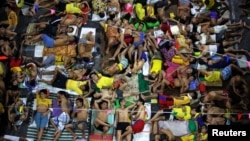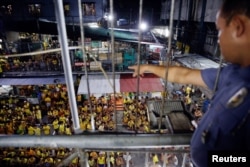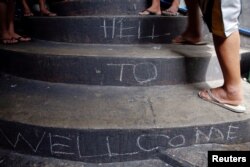Jason Madarang, awaiting trial on a charge of drug use, is in a muggy, windowless cell in a Manila prison so overcrowded that inmates must sleep in halls and stairwells and share each toilet with 150 other men.
But with President Rodrigo Duterte’s “war on drugs” raging beyond the walls of Quezon City Jail, Madarang says he is lucky.
“It’s safer here,” he said. “Outside, if the police want to shoot you, they shoot you, and then say you’re a drug pusher.”
The Philippines police say they have only shot drug suspects in legitimate operations. Nearly 2,300 drug users and dealers have been killed in police operations or by suspected vigilantes since Duterte took office June 30, according to the Philippines police.
Overcrowded jails
Thousands more have been arrested, filling the country’s already seething jails to the bursting point. Quezon City Jail was built to hold 800 inmates but is now home to more than 3,400 — far too many for its cell area, which is roughly equivalent to three basketball courts.
In mid-August, as Duterte’s anti-narcotics campaign intensified, the population briefly topped 4,000, until the jail insisted that detainees were sent elsewhere.
“If we hadn’t done that, we’d have 5,000 inmates by now,” said Lucila Abarca, the prison’s Community Relations Officer. Two-thirds of the inmates are there on drug-related offenses, according to data maintained by the prison.
Meth plays a role
Quezon City Jail is a teeming microcosm of a regional crisis driven by an explosion in use of methamphetamine, a highly addictive drug popular across Asia.
Prisons in countries such as Thailand and Myanmar are also chronically overcrowded, thanks largely to inmates on drug-related charges, according to the United Nations Office on Drugs and Crime.
But Philippine jails are Asia’s most congested, with an occupancy level of 316 percent, according to the Institute for Criminal Policy Research (ICPR) at Birkbeck, University of London. Globally, the ICPR ranks the Philippines third in prison occupancy levels, behind only Haiti and Benin.
It was natural that the government’s “aggressive campaign against criminality and drugs” would boost the jail population, said Jesus Hinlo, undersecretary for public safety at the Department of the Interior and Local Government, which is in charge of Quezon City Jail.
“The solution is ... to build new and bigger jails,” he said, adding that a lack of funds made this a challenge.
‘Welcome to hell’
Prison overcrowding poses “a very big challenge for us in terms of security and the health status of inmates,” said Abarca, the prison officer.
Inmates sleep poorly and easily fall sick, she said, and tensions always simmer over the cramped conditions. In July, there was a cholera outbreak caused by contaminated water.
Someone has chalked “WELCOME TO HELL” on the steps leading to Jason Madarang’s cellblock.
But the 29-year-old municipal worker, who said five people near his Manila home had been shot dead in recent months, wasn’t the only inmate who felt safer there.
His cellmate, Marconino Maximo, 39, said he was arrested a year ago and charged with possessing a pipe for smoking crystal methamphetamine, known in the Philippines as shabu.
“I’m lucky to be here because so many people have been killed,” he said. “There are many police on the outside,” added Maximo, gesturing around his seething, dungeonlike cell. “Here, there are none.”
There are rarely any prison officers either. Most cellblocks are run by one of four gangs, whose leaders are relied upon to keep the peace, Abarca said.
“Riots can still happen,” Abarca said. “We have to conduct regular dialogue with cell leaders to address their issues.”
Inmates can’t be locked in the cells at night because the cells aren’t big enough. They sleep on the stairs — one inmate per step — and string hammocks from the rafters and spill into the chapel and classroom. Others bed down in the prison’s only exercise area, its basketball court, when it’s not raining.
Cholera outbreak
Each morning at 8 a.m., many inmates crowd around the basketball court to sing the national anthem and take part in a short aerobic exercise.
Inmates are encouraged to be as active as possible during the day, Abarca said. But, inmates told a Reuters journalist touring the prison that many men catch up on sleep during the day in the space left by cellmates who exercise, pray in the chapel or form long lines for one of 24 toilets.
At least 2,000 inmates are inside on bailable offenses, according to prison statistics, but most are too poor to pay the bond. The overcrowding is also a symptom of the slow pace of Philippines justice. Many inmates wait years for their cases to grind through courts.
Duterte’s anti-narcotics crackdown is popular with the public — 84 percent of respondents approved of the campaign in an opinion poll last month. But some critics say it has been felt disproportionately by the poor, and that major drug traffickers routinely evade arrest.
Given the choice, former drug user Dennis Charles Ledda, 29, said he would take his chances on the outside.
“It’s hell here, mentally and physically,” said Ledda, who sleeps in the crawl space beneath another man’s bunk. “Truly, I used drugs,” he said. “But if I could get out of here I’d do anything to fix my life.”












